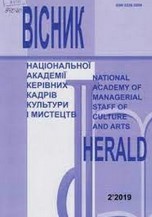ВИШИТИЙ І ТКАНИЙ РУШНИК ЯК СКЛАДОВА ЧАСТИНА КУЛЬТУРНОГО КОДУ НАРОДНОГО КОСТЮМА НАРЕЧЕНОЇ
EMBROIDERED AND WOVEN TOWEL (RUSHNYK) AS PART OF CULTURAL CODE OF BRIDE’S TRADITIONAL COSTUME
Author(s): Olena Stalyevna AfoninaSubject(s): Cultural history, Customs / Folklore, Sociology of Culture
Published by: Національна академія керівних кадрів культури і мистецтв
Keywords: cultural code; embroidered towel (rushnyk); traditional costume of a bride; women’s clothing; belt; ornament; Ukrainian traditional costume; traditions;
Summary/Abstract: The purpose of the article is to study the specific role of the embroided towel (rushnyk) as a key element of women’s wedding clothing in the context of its cultural code; outlining the concept of cultural code in terms of decorative art and people’s worldview; to determine the role of the embroidered towel (rushnyk) in women’s wedding costume. The methodology of the study is based on the principle of historicism, systematicity and author’s objectivity. General scientific methods of analysis, analogies, modeling, and systemic analysis have also been used. Scientific novelty. The article reveals for the first time the specifics of the embroidered towel (rushnyk) as an element of cultural code of women’s wedding clothing of the Ukrainian people. The role of the embroided towel (rushnyk) in a traditional costume of a bride is outlined as one of its key elements having a protective meaning, considering its use as personification of a belt. The reasons for such rituals are explained. Conclusions. By analysing particular items of decorative and applied arts (embroided towels, costume elements), as well as a set of rituals and examples of oral folk arts related to the topic of the study, it has been proved that the embroidered towel (rushnyk) in wedding rituals of the Ukrainian people plays an important role precisely in terms of using it as an element of cultural code of the bride’s clothing. A number of examples reveal the ways of tying it to a bride and a groom, as well as other participants of the ceremony. For this purpose, wedding pictures and illustrations depicting brides and grooms in traditional festive costumes were used. They included, in particular, illustrations of wedding clothing of young people from Kherson county of Kherson province, costumes of newly married couples from Novhorod-Siverskyi county of Chernihiv province, a picture of a wedding in the village of Borovykove, Cherkasy region (mid-20th century).
Journal: Вісник Національної академії керівних кадрів культури і мистецтв
- Issue Year: 2022
- Issue No: 3
- Page Range: 89-94
- Page Count: 6
- Language: Ukrainian

